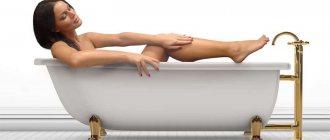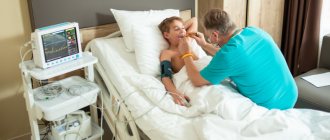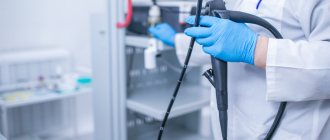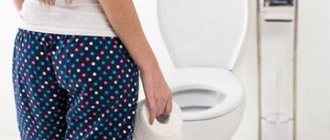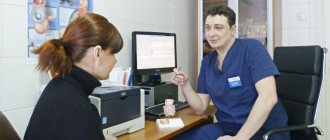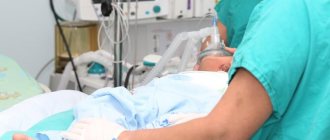Home » Diagnostics » Examination by a coloproctologist » Preparing for an appointment with a proctologist
A proctologist is a highly specialized doctor who specializes in the prevention, diagnosis and treatment of proctological diseases. We are talking about problems associated with the large intestine and pararectal area. A medical professional treats pathologies such as:
- benign and malignant neoplasms;
- fistulas and growths;
- hemorrhoids of any stage;
- ulcerative colitis;
- Crohn's disease;
- chronic and acute proctitis;
- dysbacteriosis;
Proctologists treat infectious and inflammatory processes, lesions of the colon, and gastrointestinal disorders. According to medical statistics, patients are sent for diagnostic tests and an appointment with a proctologist when the pain is unbearable and their condition worsens significantly. In the early stages, most patients self-medicate, thereby worsening the condition and aggravating the disease.
People believe that their illness is shameful, but this opinion is wrong. The later the patient seeks qualified help, the longer and more difficult the treatment will be . Every day the condition worsens, even if the person does not physically feel it. The intestinal walls become thinner, the mucous membrane becomes irritated. An infection spreads in the body and affects other internal organs.
If the first symptoms appear, immediately seek help from a proctologist. The attending physician will examine the affected area, conduct an examination with palpation, thereby determining the presence of tumors, anal fissures, infectious and inflammatory processes. After this, the patient is sent for laboratory tests. These include a general blood test, urine and stool tests. In some cases, an occult blood test will be required.
After laboratory diagnostics, the results are sent to the patient’s attending physician. The proctologist analyzes the results and sends the patient for instrumental diagnostic examinations, such as endoscopy, ultrasound, computed tomography. Modern technology and equipment make it possible to establish an accurate diagnosis at an early stage of the disease. The final stage of consultation with a proctologist is the drawing up of an individual treatment plan. For each patient, a plan is drawn up individually and treatment methods are selected.
During the treatment and rehabilitation period, the patient regularly visits the attending physician, who monitors the condition, monitors improvements and deteriorations.
When should you visit a proctologist?
According to medical statistics, hemorrhoids are diagnosed in 80% of people of working age. In most patients, the disease is just beginning to develop, so there are no symptoms. In some patients, symptoms begin to appear, but the person is in no hurry to see a doctor because of embarrassment. When the pain intensifies, the patient still goes for an appointment. When should you contact a proctologist ?
Pay attention to symptoms such as trauma to the anus, hemorrhoids, and the appearance of hemorrhoids of any size. A signal that indicates impaired functioning of the body is nausea and vomiting after eating, flatulence and bloating. Gastrointestinal disorders have a negative impact on the intestines. With persistent diarrhea, the mucous membrane becomes irritated and the anus becomes red and swollen. Chronic constipation, in turn, provokes injury to the intestinal walls and the appearance of anal fissures.
You should also visit a proctologist if the following symptoms are present:
- fistulas and polyps;
- pain in the anus;
- oncology;
- impurities of blood, pus and mucus in the stool;
- bloating;
- sharp pain in the lower abdomen;
- anemia or anemia;
Lack of appetite, insomnia and constant fatigue also indicate the development of a pathological process.
Who needs and doesn’t need to prepare for the reception
Everyone needs to prepare for an appointment with a proctologist. But there is an exception to the rule - this is the initial consultation. Such a visit to a proctologist lasts about an hour, involves collecting an anamnesis (including family, genetic), and reconstructs the exact picture of the disease in a question-and-answer mode. If the anamnesis provides a clear picture of the suspected pathology, the patient receives a referral for a follow-up visit for an internal examination of the intestine. If things are unclear, the patient is referred to related specialists for a differential diagnosis.
There is another option when you can show up for the first appointment without preparation - this is severe pain. In such a situation, the doctor will provide all possible first aid, but will not be able to carry out a full diagnosis. Only after the pain attack has subsided and preparation has been carried out, the patient will return for the second appointment.
Preparing for examination by a proctologist
Before visiting a proctologist, certain preparations should be made. When visiting specialists of a narrow profile, preparation must be thorough. Take care of your diet. You should eat 5 times a day in small portions. A balanced diet has a positive effect on the functioning of the gastrointestinal tract and normalizes stool. Eliminate legumes, flour, confectionery, and cabbage from your diet. It is strictly forbidden to consume foods high in fiber, fatty and smoked. Such products cause gas formation and disrupt bowel movements.
It is advisable to exclude raw fruits and vegetables and sugar from the diet. Include porridges and broths, fermented milk products, rye bread, and plenty of fluids in your diet. It is prohibited to consume alcoholic and carbonated drinks, juices with pulp. It is recommended to eat no later than an hour and a half before visiting the proctologist. If bloating is observed, you can take the drug Espumisan.
Take care of hygiene. Rinse the anus with warm water and chamomile infusion. This way the affected area will be disinfected. Intestinal cleansing should be done. There are two ways to do this:
- mechanical rinsing using an enema;
- use of laxatives;
If the patient has acute pain in the intestines before taking it, you should not cleanse the body yourself. It is better to go to a doctor who will examine the patient in a state where the disease is progressing and prescribe painkillers and anti-inflammatory drugs. After pain relief, diagnostic and laboratory tests will be performed.
Visual examination
The doctor begins the examination from the preanal zone.
At the end of the conversation, the patient is naked and moves to the chair for a proctological examination. The structure of the chair is similar to an ordinary gynecological chair.
For the male contingent, this chair will be a novelty. It is the design of the chair that allows the doctor to freely examine the rectal area and carry out the necessary actions.
Why is a colon cleanse performed?
As you know, it is impossible to conduct an examination without a cleansing enema. Cleansing the intestines is necessary in order to make an accurate diagnosis and analyze the patient’s condition as much as possible. Visual and hardware inspections will not bring problems or inconvenience; the procedure will be as informative as possible. The cleansing procedure is performed two hours before visiting the doctor. In this case, the patient is given two cleansing enemas, with a break between them of half an hour.
It is recommended to cleanse the body using the drug Microlax. Please read the instructions first to determine the indications and contraindications for the components of the drug. The drug has a double effect. Microlax normalizes metabolism, simplifies bowel movements and softens stool. In addition, the components increase fluid in the intestines. There are no contraindications other than individual intolerance to the drug.
How to use Microlax before taking it? The use of the product is considered convenient and does not cause discomfort. The effect of the medicine is gentle and effective at the same time. You should open the tube with Microlax, press and lubricate the tip. After this, insert the tip into the anus to its full length. Inject the medication into the anus and then remove the tip. The body will be cleansed within a few minutes after administration of the product. Cleansing the body should be carried out three hours before visiting the proctologist.
Enema. Methodology of the procedure
The colon cleansing procedure is carried out 3-4 hours before the expected visit to the doctor. The patient will have to do 2 cleansing enemas. The break between procedures is 45 minutes. The water temperature should be pleasantly warm – 36–37 degrees. If you go to a morning appointment, then it is advisable to carry out cleansing procedures before bedtime. If the appointment is scheduled for the evening, then the enema can be done after the morning toilet. So, instruments and materials:
- Exmarch mug - a container resembling a heating pad with a hose, tip and clamp
- Warm water
- Oilcloth so as not to stain the trestle bed or bed
- Soap
The volume of the Exmarch mug is from 1.5 to 2 liters. The tip on the hose can be glass or plastic about 10 cm long. The latter is more preferable. If you have a device with a glass tube, be sure to check it - there should be no chips or sharp edges. Before the procedure, thoroughly wash the tip with soap.
Check the clamp on the hose. It doesn't matter if this part is broken or lost! It can be easily replaced with a regular clothespin. All is ready! Let's start cleansing the body:
How is a proctologist examined?
Initially, the attending physician gets to know the patient, analyzes the complaints and symptoms that worry the patient. After this, the proctologist answers questions, clarifies the nature and intensity of pain. We are talking about appetite, bowel movements, frequency of bowel movements, and the presence of acute pain. Attention is paid to the presence of mucus impurities. Blood or pus in the stool. The proctologist also clarifies information regarding dietary habits, general health, weakness or headaches.
The doctor must clarify whether the patient was self-medicating before the appointment. After this, an initial examination and palpation of the anus is carried out. The patient is sent to the examination room, where he is given disposable medical underwear. The underwear has an incision in the anus area. It is necessary to remove clothes to the waist and lie in a lying position on your side, pressing your knees to your chest.
A visual examination includes assessing the severity of the condition and diagnosing neoplasms. The proctologist performs a digital examination. Before this, the medical worker must treat his hands with antiseptics and apply an anesthetic to the anus to eliminate pain during the examination. The attending physician evaluates the condition of the muscles and mucous membranes and detects the presence of a pathological process. Palpation is necessary in order to determine the presence of contraindications when performing an endoscopic examination.
Content
- Inspection stages
- Basic methods of examination by a proctologist
As surprising as it may seem in our time, some of my patients are afraid of being examined by a proctologist. True, after it is carried out, all those who are afraid are surprised that the examination is painless and claim that they were afraid in vain.
Let's get rid of such fears and take care of the most precious thing we have - our health. This article is for you and your friends.
So, you came to the proctologist for an appointment. You have already prepared (the administrator talks about this stage in detail).
The beginning began - a conversation with the doctor. Without any embarrassment, tell us about your illness as you imagine it, preferably in detail. The doctor will clarify those details that are most important in diagnosing the disease and building a picture of the patient’s health. The doctor will write down the most important details in the outpatient card. Then, having signed consent for examination (as it should be in the modern world), the patient goes to the treatment room.
There he will be met by a nurse - a doctor's assistant - and will tell him how to prepare directly for the examination. At this stage, the patient undresses; you can wear special disposable underwear. The nurse will then help the patient lie down correctly on the examination table to make the examination as comfortable as possible. A position is taken on the left side, similar to a fetal position. This position is aesthetically most acceptable for examination and is comfortable for both the patient and the doctor conducting the examination.
Diagnosis of proctological diseases
What diagnostic methods are used to identify proctological pathologies? The most popular method is anoscopy. This is a procedure that examines the rectum and anus using an anoscope. The manipulation does not cause discomfort to the patient. If discomfort is still present, the doctor applies an anesthetic gel to the affected area.
Colonoscopy is often performed in medical practice. The colonoscope is inserted into the anus, after which the condition of the mucous membrane and all parts of the intestine is demonstrated on a special screen. The colonoscope tube contains a small camera that helps visualize the internal organs.
Colonoscopy is considered a low-traumatic diagnostic method. The duration of the procedure is forty minutes. Recovery after manipulation is not long. The patient recovers from anesthesia, comes to his senses, and then returns to his usual lifestyle. It is imperative to cleanse the intestines before the procedure. It is worth cleaning the intestines as much as possible. If feces and food remain in the body, visibility will become difficult. The results of the study will not be as accurate.
For each patient, a strict diet is drawn up individually and a preparation plan is drawn up. We are talking about giving up certain foods and taking medications. It is advisable to exclude raw fruits and vegetables, milk, baked goods and high-fiber foods from the diet. It is difficult to see the intestines when consuming confectionery, carbonated drinks, salty and fried foods.
Diagnosis of proctological pathologies includes laboratory tests, for example, testing blood, urine and feces for occult blood. First of all, you should contact a proctologist, who will refer the patient for the necessary studies.
Using tools
Anoscopy as a diagnostic method.
The most accessible and elementary method is anoscopy. An anoscope is used for this method. This is a specific rectal speculum.
During this examination, the patient is in the usual position on the proctology chair. There is no need for additional anesthesia.
Anoscopy allows you to see almost everything that a proctologist can treat: fistulas, fissures, nodes, pararoctitis, neoplasms, proctitis.
Preparation at the Proctology Clinic
Preparation for examination by a proctologist and sigmoidoscopy can be done directly at the Proctology Clinic of the Altermed group of clinics. If independent bowel preparation is difficult for you for some reason or you can only come to see a doctor in the evening, after work, we have the opportunity to carry out the preparation in a specially equipped room. This procedure will lengthen the reception by about 20 minutes, but this will save you from fasting and other problems associated with self-preparation.
IMPORTANT:
sigmoidoscopy is the most important study for the prevention and early diagnosis of cancer.

